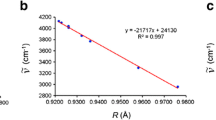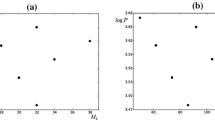Abstract
New expressions for the energy and the length of interatomic bonds depending on atomic number, bond order, and angular momentum are derived within the theory of generalized charges, which is an asymptotic approximation for interatomic forces in the quantum-statistical model of a multicomponent electron gas. In particular, expressions for bond energies and bond lengths in hydrides are derived as functions of atomic numbers. As a consequence of the developed theory, hydrogen bonding is viewed as a one-electron covalent bonding, which is used to derive corresponding quantitative relations. The energy of hydrogen bonding cannot be lower than some specific value determined by the charge of the bonded atom. The region of existence of hydrogen bonding is established. The boundaries of the region are determined by the classes of substances distinguished by their ability to form hydrogen bonding. Quantitative estimations are used to explain the ability or inability of substances containing electronegative atoms to dissolve in water.
Similar content being viewed by others
References
L. Pauling. Nature, 1948, 161, 707.
N. D. Sokolov. Usp. Fiz. Nauk, 1955, 57, 205.
P. Hobza. Annu. Rep. Prog. Chem. Sect., 2004, 100, 3.
J. J. Dannenberg, L. Haskamp, and A. Masunov. J. Phys. Chem. A, 1999, 103, 7083.
B. G. Oliveira and M. L. A. A. Vasconcellos. J. Mol. Struct.: THEOCHEM, 2006, 774, 83.
T. K. Ghant, V. N. Staroverov, P. R. Koren, and E. R. Davidson. J. Am. Chem. Soc., 2000, 122, 1210.
A. M. Dolgonosov. Russ. J. Inorg. Chem., 2000, 45, 897.
A. M. Dolgonosov. Rus. J. Phys. Chem., 2000, 74, S324.
A. M. Dolgonosov. Russ. J. Phys. Chem. A, 2001, 75, 1659.
A. M. Dolgonosov. Russ. J. Phys. Chem. A, 2002, 76, 993.
A. M. Dolgonosov. Russ. J. Phys. Chem. A, 2002, 76, 2015.
A. M. Dolgonosov. Russ. J. Phys. Chem. A, 2003, 77, 764.
A. M. Dolgonosov. Russ. J. Phys. Chem. A, 2008, 82, 2079.
A. M. Dolgonosov. Model’ Elektronnogo Gaza i Teoriya Obobschennykh Zaryadov Dlya Opisaniya Mezhatomnykh Vzaimodeistviy i Adsorbtsii (Electron Gas Model and Theory of Generalized Charges for Description of Interatomic Interactions) [in Russian]. LIBROKOM: Moscow, 2009.
A. M. Dolgonosov. Nespetsificheskaya selektivnost’ v Probleme Modelirovaniya Vysokoeffektivnoy Khromatografii (Nonspecific Selectivity in the Problem of Modeling of High-performance Chromatography) [in Russian]. KRASAND: Moscow, 2012.
A. M. Dolgonosov. Russ. Chem. Bull., 2016, 65, 952.
A. M. Dolgonosov. Russ. J. Inorg. Chem., 2015, 60, 194.
A. M. Dolgonosov. Russ. J. Inorg. Chem., 2017, 62, 344.
A. M. Dolgonosov. Russ. J. Inorg. Chem., 2019, 64(4).
A. I. Pertsin and A. I. Kitaigorodsky. The Atom-Atom Potential Method in the Physics and Chemistry of Organic Molecular Solids. Springer Verlag: Berlin, 1986.
I. G. Kaplan. Intermolecular Interactions: Physical Picture, Computational Methods, and Model Potentials. Wiley, 2006.
N. N. Avgul’, A. V. Kiselev, and D. P. Poshkus. Adsorbtsiya Gazov i Parov na Odnorodnykh Poverkhnostyakh (Adsorption of Gases and Vapors on Homogeneous Surfaces). Khimiya: Moscow, 1975.
Theory of the Inhomogeneous Electron Gas / Ed. S. Lundqvist and N. H. March. Plenum Press: New York, 1983.
W. Koch and M. C. Holthausen. A Chemist’s Guide to Density Functional Theory. Wiley-VCH Verlag GmbH, 2001, 293.
J. C. Slater and K. H. Johnson. Phys. Rev. B, 1972, 5, 844.
Funding
This work was supported by the Russian Foundation for Basic Research (grant No. 18-03-00382a).
Author information
Authors and Affiliations
Corresponding author
Ethics declarations
The author declares that he has no conflict of interests.
Additional information
Russian Text © The Author(s), 2019, published in Zhurnal Strukturnoi Khimii, 2019, Vol. 60, No. 11, pp. 1765–1774.
Rights and permissions
About this article
Cite this article
Dolgonosov, A.M. Understanding Hydrogen Bonding in Terms of the Theory of Generalized Charges. J Struct Chem 60, 1693–1702 (2019). https://doi.org/10.1134/S0022476619110015
Received:
Revised:
Accepted:
Published:
Issue Date:
DOI: https://doi.org/10.1134/S0022476619110015




